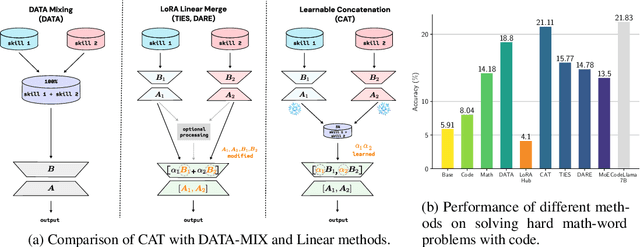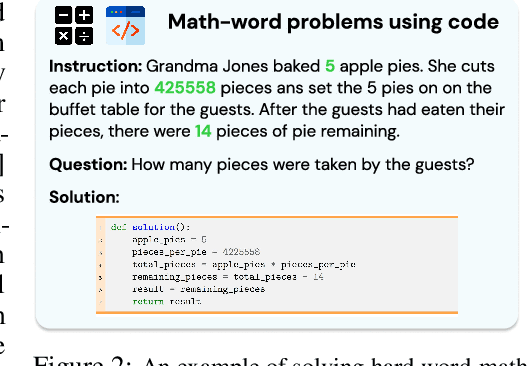Akshara Prabhakar
Grounded Test-Time Adaptation for LLM Agents
Nov 06, 2025Abstract:Large language model (LLM)-based agents struggle to generalize to novel and complex environments, such as unseen websites or new sets of functions, due to a fundamental mismatch between their pre-training and test-time conditions. This challenge stems from two distinct failure modes: a syntactic misunderstanding of environment-specific components like observation formats, and a semantic misunderstanding of state-transition dynamics, which are only revealed at test time. To address these issues, we propose two distinct and complementary strategies for adapting LLM agents by leveraging environment-specific information available during deployment. First, an online distributional adaptation method parameterizes environmental nuances by learning a lightweight adaptation vector that biases the model's output distribution, enabling rapid alignment with an environment response format. Second, a deployment-time dynamics grounding method employs a persona-driven exploration phase to systematically probe and learn the environment's causal dynamics before task execution, equipping the agent with a nonparametric world model. We evaluate these strategies across diverse agentic benchmarks, including function calling and web navigation. Our empirical results show the effectiveness of both strategies across all benchmarks with minimal computational cost. We find that dynamics grounding is particularly effective in complex environments where unpredictable dynamics pose a major obstacle, demonstrating a robust path toward more generalizable and capable LLM-based agents. For example, on the WebArena multi-site split, this method increases the agent's success rate from 2% to 23%.
UserBench: An Interactive Gym Environment for User-Centric Agents
Jul 29, 2025Abstract:Large Language Models (LLMs)-based agents have made impressive progress in reasoning and tool use, enabling them to solve complex tasks. However, their ability to proactively collaborate with users, especially when goals are vague, evolving, or indirectly expressed, remains underexplored. To address this gap, we introduce UserBench, a user-centric benchmark designed to evaluate agents in multi-turn, preference-driven interactions. UserBench features simulated users who start with underspecified goals and reveal preferences incrementally, requiring agents to proactively clarify intent and make grounded decisions with tools. Our evaluation of leading open- and closed-source LLMs reveals a significant disconnect between task completion and user alignment. For instance, models provide answers that fully align with all user intents only 20% of the time on average, and even the most advanced models uncover fewer than 30% of all user preferences through active interaction. These results highlight the challenges of building agents that are not just capable task executors, but true collaborative partners. UserBench offers an interactive environment to measure and advance this critical capability.
CRMArena-Pro: Holistic Assessment of LLM Agents Across Diverse Business Scenarios and Interactions
May 24, 2025Abstract:While AI agents hold transformative potential in business, effective performance benchmarking is hindered by the scarcity of public, realistic business data on widely used platforms. Existing benchmarks often lack fidelity in their environments, data, and agent-user interactions, with limited coverage of diverse business scenarios and industries. To address these gaps, we introduce CRMArena-Pro, a novel benchmark for holistic, realistic assessment of LLM agents in diverse professional settings. CRMArena-Pro expands on CRMArena with nineteen expert-validated tasks across sales, service, and 'configure, price, and quote' processes, for both Business-to-Business and Business-to-Customer scenarios. It distinctively incorporates multi-turn interactions guided by diverse personas and robust confidentiality awareness assessments. Experiments reveal leading LLM agents achieve only around 58% single-turn success on CRMArena-Pro, with performance dropping significantly to approximately 35% in multi-turn settings. While Workflow Execution proves more tractable for top agents (over 83% single-turn success), other evaluated business skills present greater challenges. Furthermore, agents exhibit near-zero inherent confidentiality awareness; though targeted prompting can improve this, it often compromises task performance. These findings highlight a substantial gap between current LLM capabilities and enterprise demands, underscoring the need for advancements in multi-turn reasoning, confidentiality adherence, and versatile skill acquisition.
APIGen-MT: Agentic Pipeline for Multi-Turn Data Generation via Simulated Agent-Human Interplay
Apr 08, 2025Abstract:Training effective AI agents for multi-turn interactions requires high-quality data that captures realistic human-agent dynamics, yet such data is scarce and expensive to collect manually. We introduce APIGen-MT, a two-phase framework that generates verifiable and diverse multi-turn agent data. In the first phase, our agentic pipeline produces detailed task blueprints with ground-truth actions, leveraging a committee of LLM reviewers and iterative feedback loops. These blueprints are then transformed into complete interaction trajectories through simulated human-agent interplay. We train a family of models -- the xLAM-2-fc-r series with sizes ranging from 1B to 70B parameters. Our models outperform frontier models such as GPT-4o and Claude 3.5 on $\tau$-bench and BFCL benchmarks, with the smaller models surpassing their larger counterparts, particularly in multi-turn settings, while maintaining superior consistency across multiple trials. Comprehensive experiments demonstrate that our verified blueprint-to-details approach yields high-quality training data, enabling the development of more reliable, efficient, and capable agents. We open-source both the synthetic data collected and the trained xLAM-2-fc-r models to advance research in AI agents. Models are available on HuggingFace at https://huggingface.co/collections/Salesforce/xlam-2-67ef5be12949d8dcdae354c4 and project website is https://apigen-mt.github.io
ActionStudio: A Lightweight Framework for Data and Training of Large Action Models
Mar 31, 2025Abstract:Action models are essential for enabling autonomous agents to perform complex tasks. However, training large action models remains challenging due to the diversity of agent environments and the complexity of agentic data. Despite growing interest, existing infrastructure provides limited support for scalable, agent-specific fine-tuning. We present ActionStudio, a lightweight and extensible data and training framework designed for large action models. ActionStudio unifies heterogeneous agent trajectories through a standardized format, supports diverse training paradigms including LoRA, full fine-tuning, and distributed setups, and integrates robust preprocessing and verification tools. We validate its effectiveness across both public and realistic industry benchmarks, demonstrating strong performance and practical scalability. We open-sourced code and data at https://github.com/SalesforceAIResearch/xLAM to facilitate research in the community.
SpecTool: A Benchmark for Characterizing Errors in Tool-Use LLMs
Nov 20, 2024



Abstract:Evaluating the output of Large Language Models (LLMs) is one of the most critical aspects of building a performant compound AI system. Since the output from LLMs propagate to downstream steps, identifying LLM errors is crucial to system performance. A common task for LLMs in AI systems is tool use. While there are several benchmark environments for evaluating LLMs on this task, they typically only give a success rate without any explanation of the failure cases. To solve this problem, we introduce SpecTool, a new benchmark to identify error patterns in LLM output on tool-use tasks. Our benchmark data set comprises of queries from diverse environments that can be used to test for the presence of seven newly characterized error patterns. Using SPECTOOL , we show that even the most prominent LLMs exhibit these error patterns in their outputs. Researchers can use the analysis and insights from SPECTOOL to guide their error mitigation strategies.
Language Models are Hidden Reasoners: Unlocking Latent Reasoning Capabilities via Self-Rewarding
Nov 06, 2024Abstract:Large language models (LLMs) have shown impressive capabilities, but still struggle with complex reasoning tasks requiring multiple steps. While prompt-based methods like Chain-of-Thought (CoT) can improve LLM reasoning at inference time, optimizing reasoning capabilities during training remains challenging. We introduce LaTent Reasoning Optimization (LaTRO), a principled framework that formulates reasoning as sampling from a latent distribution and optimizes it via variational approaches. LaTRO enables LLMs to concurrently improve both their reasoning process and ability to evaluate reasoning quality, without requiring external feedback or reward models. We validate LaTRO through experiments on GSM8K and ARC-Challenge datasets using multiple model architectures. On GSM8K, LaTRO improves zero-shot accuracy by an average of 12.5% over base models and 9.6% over supervised fine-tuning across Phi-3.5-mini, Mistral-7B, and Llama-3.1-8B. Our findings suggest that pre-trained LLMs possess latent reasoning capabilities that can be unlocked and enhanced through our proposed optimization approach in a self-improvement manner. The code of LaTRO is available at \url{https://github.com/SalesforceAIResearch/LaTRO}.
CRMArena: Understanding the Capacity of LLM Agents to Perform Professional CRM Tasks in Realistic Environments
Nov 04, 2024Abstract:Customer Relationship Management (CRM) systems are vital for modern enterprises, providing a foundation for managing customer interactions and data. Integrating AI agents into CRM systems can automate routine processes and enhance personalized service. However, deploying and evaluating these agents is challenging due to the lack of realistic benchmarks that reflect the complexity of real-world CRM tasks. To address this issue, we introduce CRMArena, a novel benchmark designed to evaluate AI agents on realistic tasks grounded in professional work environments. Following guidance from CRM experts and industry best practices, we designed CRMArena with nine customer service tasks distributed across three personas: service agent, analyst, and manager. The benchmark includes 16 commonly used industrial objects (e.g., account, order, knowledge article, case) with high interconnectivity, along with latent variables (e.g., complaint habits, policy violations) to simulate realistic data distributions. Experimental results reveal that state-of-the-art LLM agents succeed in less than 40% of the tasks with ReAct prompting, and less than 55% even with function-calling abilities. Our findings highlight the need for enhanced agent capabilities in function-calling and rule-following to be deployed in real-world work environments. CRMArena is an open challenge to the community: systems that can reliably complete tasks showcase direct business value in a popular work environment.
LoRA Soups: Merging LoRAs for Practical Skill Composition Tasks
Oct 16, 2024



Abstract:Low-Rank Adaptation (LoRA) is a popular technique for parameter-efficient fine-tuning of Large Language Models (LLMs). We study how different LoRA modules can be merged to achieve skill composition -- testing the performance of the merged model on a target task that involves combining multiple skills, each skill coming from a single LoRA. This setup is favorable when it is difficult to obtain training data for the target task and when it can be decomposed into multiple skills. First, we identify practically occurring use-cases that can be studied under the realm of skill composition, e.g. solving hard math-word problems with code, creating a bot to answer questions on proprietary manuals or about domain-specialized corpora. Our main contribution is to show that concatenation of LoRAs (CAT), which optimally averages LoRAs that were individually trained on different skills, outperforms existing model- and data- merging techniques; for instance on math-word problems, CAT beats these methods by an average of 43% and 12% respectively. Thus, this paper advocates model merging as an efficient way to solve compositional tasks and underscores CAT as a simple, compute-friendly and effective procedure. To our knowledge, this is the first work demonstrating the superiority of model merging over data mixing for binary skill composition tasks.
xLAM: A Family of Large Action Models to Empower AI Agent Systems
Sep 05, 2024



Abstract:Autonomous agents powered by large language models (LLMs) have attracted significant research interest. However, the open-source community faces many challenges in developing specialized models for agent tasks, driven by the scarcity of high-quality agent datasets and the absence of standard protocols in this area. We introduce and publicly release xLAM, a series of large action models designed for AI agent tasks. The xLAM series includes five models with both dense and mixture-of-expert architectures, ranging from 1B to 8x22B parameters, trained using a scalable, flexible pipeline that unifies, augments, and synthesizes diverse datasets to enhance AI agents' generalizability and performance across varied environments. Our experimental results demonstrate that xLAM consistently delivers exceptional performance across multiple agent ability benchmarks, notably securing the 1st position on the Berkeley Function-Calling Leaderboard, outperforming GPT-4, Claude-3, and many other models in terms of tool use. By releasing the xLAM series, we aim to advance the performance of open-source LLMs for autonomous AI agents, potentially accelerating progress and democratizing access to high-performance models for agent tasks. Models are available at https://huggingface.co/collections/Salesforce/xlam-models-65f00e2a0a63bbcd1c2dade4
 Add to Chrome
Add to Chrome Add to Firefox
Add to Firefox Add to Edge
Add to Edge